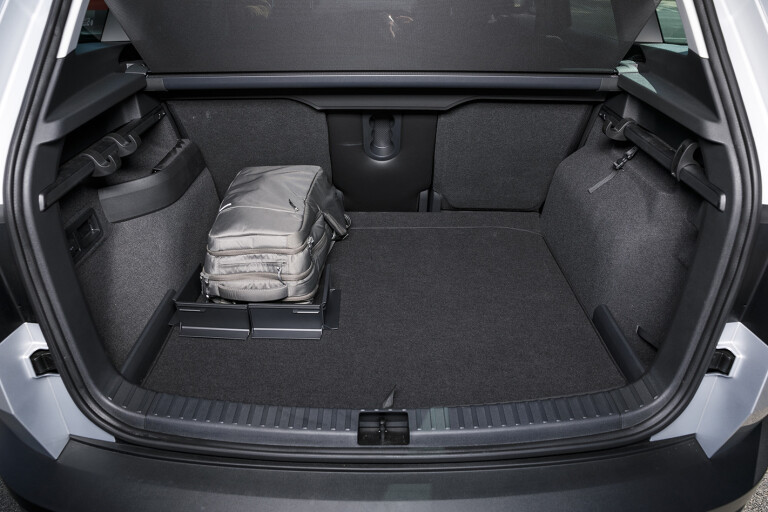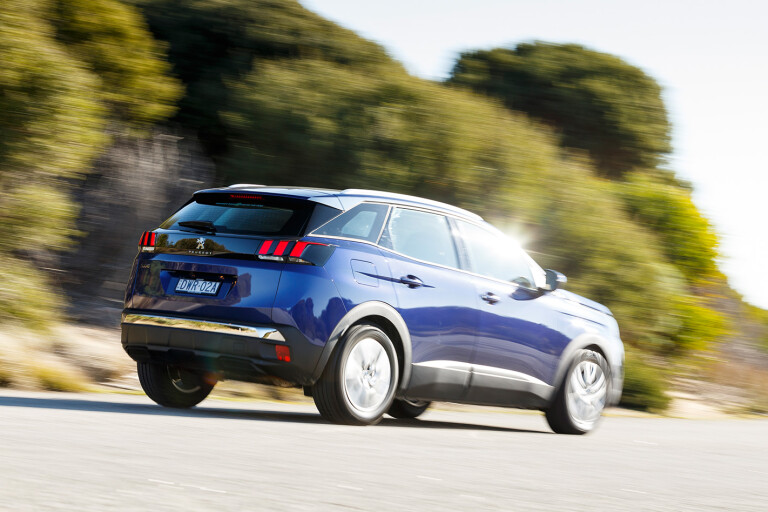
We certainly don’t blame shoppers for gravitating toward the status quo. After all, if the bulk of the country’s car buyers favour a certain vehicle, then it surely must be a good thing, right?
However there’s still value in casting your net a little wider. Do so, and you might find yourself with something with a little more polish for not a lot more cost.
Case in point: the newly-arrived Skoda Karoq and the still-fresh Peugeot 3008 Active. As European options in a medium SUV segment that’s largely dominated by Korean and Japanese manufacturers, the Czech-built Skoda and French-built Peugeot are often overlooked, but with the former retailing at $32,290 and the latter starting at $36,990 they’re nevertheless compelling value against a large number of mid-to-high-spec Asian competitors.
We threw them against each other in a battle of the mid-SUV wildcards to see which high-riding European wagon makes the stronger case.

VALUE
The Karoq range opens under $30K, however that attention-getting $29,990 price-tag is attached to the six-speed manual, not the automatic-equipped model that most buy. Opt for the auto and the price of entry rises to $32,290.
The Karoq is only available in one grade for now, but you’ll need to tick a couple of option boxes. One is the $1700 Travel Pack to add blind spot monitoring, lane departure warning, rear cross traffic alert, a powered driver’s seat and heated front seats. The other is the $3600 Premium Pack, which brings leather upholstery, nice-looking 18-inch alloys, LED headlamps, front and rear parking sensors and a powered tailgate. Our test car was equipped with both, plus metallic paint, which brought the total retail price to $38,290.

The Peugeot 3008 Active is better equipped as standard, so there’s less need to reach for the option sheet. Its base price is higher as a result - $36,990 for the Active – but remember that’s for a well-equipped auto-only. With the additional cost of metallic paint, the as-tested of our 3008 came to $38,180. With just $110 between the two when specced to a very similar level, the Czech-built Skoda and French-built 3008 are astonishingly close in price.
As far as fuel consumption goes, the Peugeot burned 9.2L/100km during our testing while the Karoq consumed 9.6L/100km. After-sales care is an identical 5 years/unlimited kilometres of warranty for both, and servicing intervals are set at 12 months/20,000km for the Peugeot and 12 months/15,000km for the Skoda. That difference is moot for most Australians, with our average annual usage amounts to 14,000km.
While the Peugeot would appear to have an advantage here, that's eroded by high scheduled servicing costs. Prices alternate between $466 and $789 for the 3008 Active 1.6 petrol, while the Skoda's services range between $288 and $583 depending on where you are in the servicing schedule.

STANDARD FEATURES
The fairest comparison is only possible by optioning the Karoq to the level described above, but when you do the question of “which is better equipped” largely comes down to which features you value more than others. The Karoq boasts a powered tailgate and 18-inch wheels thanks to the aforementioned Premium Pack, features that aren't on the Peugeot 3008 Active, but the Peugeot counters with standard-issue integrated satellite navigation and a wireless phone charging pad.
Active cruise control is standard on all Karoq models, however, and 'surprise and delight' features are more abundant on the Skoda too, things like an integrated umbrella compartment under the front seat, a removable LED torch in the boot area and a pair of tablet holders to help keep backseat travellers entertained. They don't necessarily make the Skoda a better car to drive, but they certainly make it a more liveable vehicle.

And while Skoda doesn't make satellite navigation standard-fit on the Karoq, it has at least brought smartphone mirroring functionality to the car's otherwise superb 8-inch colour infotainment display. Peugeot's touchscreen is a decent bit of gear, but if you can live with plugging your smartphone into the Skoda whenever you need to navigate somewhere we'd give the Czech the nod for this round.
SIZE
Both are similarly sized, with the Peugeot occupying a 4447mm long and 1826mm wide footprint and the Karoq measuring 4382mm in length and 1841mm in width. Both are five-seat wagons too, so the differences are in the details. The Skoda feels more spacious thanks to a more generous glasshouse that lets in more light, and it has a cool party trick that allows it to make better use of its size.
With the rear seats in place the Karoq's cargo capacity measures 479 litres, expanding to 1605 litres with the backrests lowered, which puts it behind the 3008's 591-1605 litre measurements. However the second row of seating not only folds forward to expand cargo space, it can be removed entirely to transform the Karoq into a two-seater van with a huge 1810 litres of stowage.

The storage options are further boosted by a pair of sturdy rails either side of the load area that allows extra shopping bag hooks to be clipped on, and a pair of removable velcro brackets keep even small backpacks secure in the boot. For its sheer versatility, the Skoda scores highly.
SAFETY
Both cars cater to the safety-conscious, with autonomous emergency braking, stability control, traction control, ISOFIX child seat anchorages fitted across their ranges as standard.
The Skoda boasts an extra airbag (for the driver's knees) to take its total to seven while the Peugeot makes do with six. The Skoda has yet to be rated by independent crash test authority ANCAP. The 3008 has been awarded a five-star crash safety rating by ANCAP.

COMFORT
The Peugeot edges ahead of the Skoda thanks to slightly more supportive seat cushions in the front and rear, along with greater legroom for backseat passengers. There's also the profound difference in cabin ambience to consider. Both feel like they've been bolted together with plenty of love and care, so build quality is line-ball, but it's the Peugeot that impresses most thanks to its breathtaking cabin design that looks and feels far more premium than the Skoda's handsome – yet very sober – interior treatment.
And while our Skoda test car came with optional leather seats, we were more impressed by the comfort and feel of the Peugeot's classy-looking houndstooth fabric upholstery. There's a flair and charm to the Peugeot's cabin that elevates it above the Skoda for aesthetic appeal. It's not for everyone, but if you want to feel like you're climbing into something special every morning it's hard to look past the Peugeot.

The Skoda is not without merit though, with a cabin that feels much brighter and airier courtesy of a more generous glasshouse and the absence of privacy glass. It's definitely crafted to cater to family buyers as well, with an elevated rear bench that gives even smaller children a decent view through the front, tablet-holders ahead of each outboard rear seat, and bigger rear door openings to ease entry and exit.
ON THE ROAD
Both contenders are at the pointy end of the segment when it comes to handling competence, and both are blessed with engines that perform strongly despite their small displacements. The pair each tip the scales under 1.4 tonnes apiece, which helps them make the most of their admittedly modest power outputs – 110kW/250Nm for the Skoda, 121kW/240Nm for the Peugeot.

The Peugeot is fractionally faster to 100km/h from standstill, hitting triple-digit speeds in 9.3 seconds versus the Skoda's 9.5 seconds. Its sportier edge flows through to its chassis as well. Big bumps are dispatched without fuss but there's a firmness to its bump response that's unexpected given its meaty sidewalls and 17-inch wheels. That nature is at least in harmony with its steering, though, which feels fast and reactive thanks to that small-diameter steering wheel and a superbly calibrated front suspension.
The Karoq's steering is accurate but very light in its weighting and less engaging as a result. Its dynamic scorecard was good, and while it pushed into understeer slightly more readily than the Peugeot and exhibited more body roll, it's nevertheless far from a sloppy handler. There were few complaints about its ride comfort either, with big bumps being ably absorbed by its MacPherson strut front and torsion-beam rear suspension (a layout shared also adopted by the Peugeot).

The difference between the two on the road boils down to this: The Skoda Karoq feels exactly how you'd expect a fairly light five-seater SUV wagon to feel, but the Peugeot 3008 adopts a more athletic persona and drives more like a hatchback – a somewhat sporty hatchback, at that.
The only area where that wasn't the case was the transmission. The Peugeot's conventional six-speed auto works great, with smooth take-up from standstill, slick shifts and intelligent shift mapping that compliments the engine. The Skoda's seven-speed dual clutch auto is the inverse – beautifully crisp gearchanges when you're pushing it hard, but occasionally unwanted jerkiness when dealing with start-stop traffic.
VERDICT
For its lovely interior, engaging and agile chassis, faultless driveability, commendable fuel economy and handsome styling, it's hard to go past the Peugeot 3008 Active.
It's the connoisseur's choice in this segment, and judging by the small numbers of them currently on Australian roads, one of the better-kept secrets. It satisfies most of the core criteria that the average mid-size SUV buyer would likely have (with perhaps the exception of having AWD), but goes even further by wrapping it up in a body and interior that simply makes you feel good. SUVs need not be boring boxy wagons, and Peugeot has proven that.
That's not to say the Skoda is without merit. It's a close-run race between these two, but the only issues that really detract from the Karoq's proposition are its higher fuel consumption, low-speed transmission refinement and the need to tick options to put it on even pegging with the 3008 Active. It's still good buying, but it's very much a head-over-heart decision. The Peugeot, on the other hand, is a car that you can actually feel emotional about.
COMMENTS